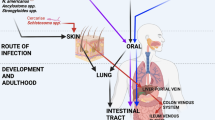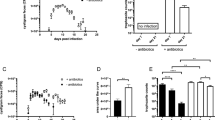Abstract
DURING the intestinal phase of nematode infections in laboratory rodents a variety of cell types is found in the gut mucosa, including mast cells and globule leukocytes1–4. After stimulation by the nematodes present either in the intestinal lumen or penetrated into the gut mucosa, the number of intestinal mast cells increases1,4. Next, mast cells invade the epithelial lining of the villi, discharge secretory products, including histamine, and change into the intra-epithelial globule leukocytes1,5. Release of mast cell secretory products is mediated by IgE antibody6. No conclusive evidence has as yet been presented, that the secretory products have a role in the expulsion of the worms.
This is a preview of subscription content, access via your institution
Access options
Subscribe to this journal
Receive 51 print issues and online access
$199.00 per year
only $3.90 per issue
Buy this article
- Purchase on Springer Link
- Instant access to full article PDF
Prices may be subject to local taxes which are calculated during checkout
Similar content being viewed by others
References
Miller, H. R. P., and Jarrett, W. F. H., Immunology, 20, 277–288 (1971).
Kelly, J. D., and Ogilvie, B. M., Int. Arch. Allergy, 43, 497–509 (1972).
Rothwell, T. L. W., and Love, R. J., J. Path., 116, 183–194 (1975).
Ruitenberg, E. J., Teppema, J. S., Kruizinga, W., Elgersma, A., and Steerenberg, P. A., Volksgezondheid, Verslagen Adviezen Rapporten, 33/34, 114–121 (1975).
Murray, M., Miller, H. R. P., and Jarrett, W. F. H., Lab. Invest., 19, 222–234 (1968).
Ishizaka, T., Ishizaka, K., and Tomioka, H., J. Immun., 108, 513–520 (1972).
Ruitenberg, E. J., Teppema, J. S., and Steerenberg, P. A., Proc. 3rd Int. Congress of Parasitology, München, 667–668 (1974).
Ruitenberg, E. J., and Steerenberg, P. A., J. Parasit., 60, 1056–1057 (1974).
Reilly, R. W., and Kirsner, J. B., Lab. Invest., 14, 102–107 (1965).
Enerbäck, L., Acta path. microbiol. scand., 66, 289–302 (1966).
Jarrett, W. F. H., Jarrett, E. E. E., Miller, H. R. P., and Urquhart, G. M., Proc. 3rd Int. Congr. Wld. Ass. Adv. Vet. Parasit. (edit. Soulsby, Elwert, Marburg/L) pp. 191–198 (1968).
Miller, H. R. P., thesis, Univ. Glasgow (1970), cited in ref. 1.
Miller, H. R. P., Lab. Invest., 24, 339–347 (1971).
Keller, R., Hess, M. W., and Riley, J. F., Experientia, 32/32, 171–172 (1976).
Grosburg, H., and Sacks, L., J. natn. Cancer Inst., 31, 1–40 (1963).
Burnet, F. M., J. Path. Bact., 89, 271–284 (1965).
Csaba, G., and Hodinka, L., Acta Biol. Acad. Sci. Hung., 21, 333–334 (1970).
Ishizaka, T., Okudaira, H., Mansen, L. E., and Ishizaka, K., J. Immun., 116, 747–754 (1976).
Author information
Authors and Affiliations
Rights and permissions
About this article
Cite this article
RUITENBERG, E., ELGERSMA, A. Absence of intestinal mast cell response in congenitally athymic mice during Trichinella spiralis infection. Nature 264, 258–260 (1976). https://doi.org/10.1038/264258a0
Received:
Accepted:
Issue Date:
DOI: https://doi.org/10.1038/264258a0
This article is cited by
-
Immunity to gastrointestinal nematode infections
Mucosal Immunology (2018)
-
Potential effector and immunoregulatory functions of mast cells in mucosal immunity
Mucosal Immunology (2015)
-
Maturation of mast cell progenitors to mucosal mast cells during allergic pulmonary inflammation in mice
Mucosal Immunology (2015)
-
The significant role of mast cells in cancer
Cancer and Metastasis Reviews (2011)
-
Development of different mast cell types in the opossum Didelphis albiventris
Anatomy and Embryology (2003)
Comments
By submitting a comment you agree to abide by our Terms and Community Guidelines. If you find something abusive or that does not comply with our terms or guidelines please flag it as inappropriate.



